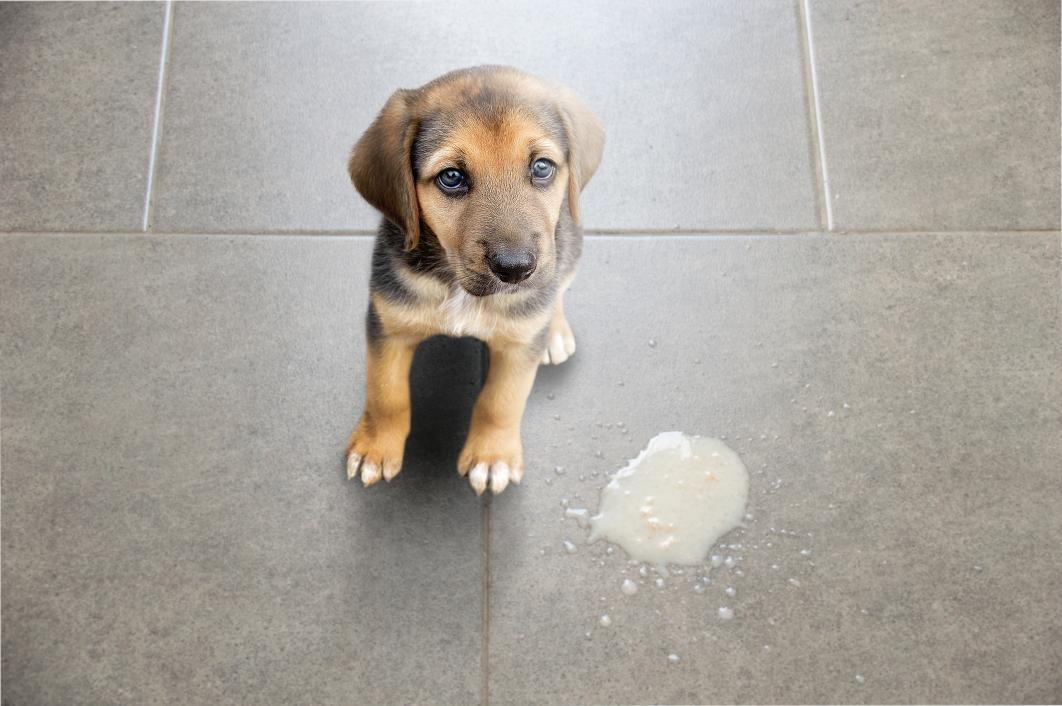
No one likes to deal with dog vomit, but the truth is that the contents of your pup’s puke can tell you a lot about what’s bothering him.
Here at Sky Canyon Animal Hospital, we want to get down and dirty about dog vomit. The next time you hear that hacking sound, you’ll be ready to investigate.
The Types of Dog Vomit, What They Mean, and What To Do
Here’s what you can learn from your pup’s gastrointestinal offerings.
Yellow or Bile Vomit
If your dog’s vomit is yellowish in color, it most likely contains bile. Produced by the liver, bile helps your dog digest food. Vomit that contains bile and nothing else can mean your pup is hungry—the bile is irritating the stomach, and because of that, vomiting ensues. If you notice yellow bile, you may need to feed your dog more frequently, or serve slightly larger portions.
What To Do: Reach out to your veterinary team to see what they think. They may suggest feeding your dog more frequently or serving slightly larger portions. You might also want to go in and get your furry companion checked for more serious conditions, like liver disease or pancreatitis.
White, Foamy Vomit
All sorts of things can cause foamy, white vomit. It’s often a sign your pet has eaten something that didn’t agree with her tummy. But it can also be a sign of a buildup in stomach acid. This could be a case of acid reflux…or it could be a parasitic infection, especially in younger dogs.
What To Do: Reach out to your veterinarian. Make note of the food and treats your dog has eaten in the past several days, as well as how many times he’s ralphed. Your veterinarian can help you pinpoint the culprit behind your pup’s distress.
Clear, Liquid Vomit
If there’s nothing but clear liquid coming out of your dog, she’s probably vomiting saliva or water. It can be a sign she drank too much water, too quickly. But it may also be a sign of nausea, indicating that more vomiting fits are on the way.
What To Do: Try offering your pet smaller amounts of fresh water throughout the day, rather than one big bowl—especially after taking him out for a run or walk. If your dog keeps vomiting clear liquid, call your veterinarian.
Grass-Filled Vomit
Ah, grass. Some dogs just love to eat it…and then puke it right back up. Grass usually induces vomiting in dogs. If your pup is feeling nauseated or sick to their stomach, they may eat grass to relieve themselves of the ill feeling. Most of the time, this type of dog vomit isn’t a big deal.
What To Do: If you notice persistent vomiting, grass-filled or otherwise, reach out to your veterinarian as soon as possible. It’s a sign of frequent gastrointestinal discomfort, and the sooner you get to the bottom of the why, the sooner your dog can feel better.
Undigested Food Vomit
Vomiting undigested food right after eating might mean your dog is eating too quickly. It can also mean there’s something blocking your pup’s intestines, preventing the food from going down its normal path.
What To Do: Try slowing things down to see if that helps. Use a puzzle feeder or slow-feeding bowl, which forces your dog to eat more slowly and provides a brain-bending challenge. If that doesn’t help or if the vomiting persists, see your veterinarian as soon as possible.
Blood-Tinged Vomit
Blood in your pet’s vomit is always a cause for concern, and you should take your pet to the vet right away. You may notice bright red blood in the vomit, or dried, brown bits that look like coffee grounds. Bloody vomit can indicate a host of serious problems, from internal bleeding to ingestion of a foreign object.
What to Do: Call your vet ASAP or dial your nearest emergency veterinary hospital if it’s after hours.
If you’re concerned about your dog’s vomit, give us a call at 951-461-4100 to schedule an appointment with our caring veterinary team.

